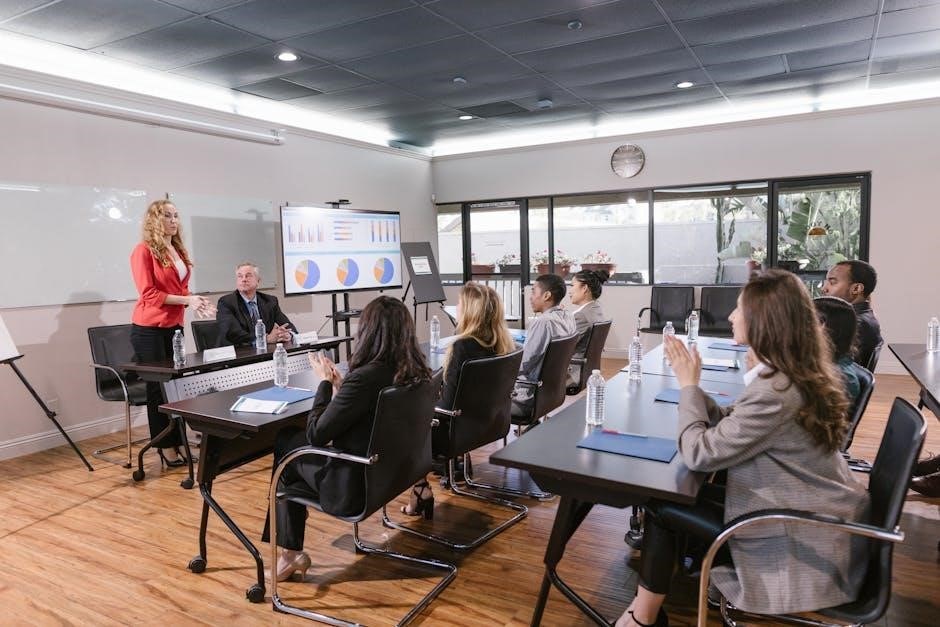stages of team development pdf
Tuckman’s stages of team development provide a framework for understanding how teams evolve. This model is crucial for effective team management and enhancing collaboration, helping predict challenges.
Historical Background of the Model
Bruce Tuckman introduced his stages of team development in 1965, outlining the process teams follow to become high-performing. Initially, the model included four stages: Forming, Storming, Norming, and Performing. In 1977, Tuckman added a fifth stage, Adjourning, to describe team dissolution. This framework has become a cornerstone for understanding group dynamics, offering insights into how teams mature and collaborate. Tuckman’s work remains influential in psychology and organizational studies, providing a structured approach to team development and leadership strategies. The model’s evolution reflects its adaptability to diverse team environments, solidifying its relevance in modern teamwork and management practices.
Importance of Understanding Team Development Stages
Understanding Tuckman’s stages of team development is essential for effective leadership and collaboration. By recognizing each phase, leaders can predict challenges, adapt strategies, and guide teams toward success. This model helps in fostering cohesion, addressing conflicts, and enhancing productivity. It provides a roadmap for leaders to support their teams during formation, conflict resolution, and high performance. Recognizing these stages also enables teams to communicate better and align with shared goals. Ultimately, this understanding promotes a smoother transition through developmental phases, ensuring teams reach their full potential and achieve desired outcomes efficiently.

Stage 1: Forming
The forming stage is the initial phase where team members orient themselves, seek approval, and avoid conflict. Roles are unclear, and dependency on the leader is high.
Characteristics of the Forming Stage
The forming stage is marked by uncertainty and orientation as team members get to know each other. Roles and responsibilities are unclear, leading to dependency on the leader for direction. Communication is polite but tentative, with individuals seeking approval and avoiding conflict. There is a focus on building trust and establishing relationships. The team is highly dependent on the leader for guidance, and decisions are often centralized. This stage lays the foundation for future collaboration, but productivity is low as members navigate their roles and responsibilities.
Challenges Teams Face in the Forming Stage
During the forming stage, teams face challenges such as unclear roles and responsibilities, leading to confusion and overlap. Members may hesitate to take initiative, unsure of their contributions. Communication is tentative, and conflicts are avoided, potentially masking underlying issues. The team’s reliance on the leader for direction can slow decision-making. Additionally, the lack of clear expectations and goals may result in disjointed efforts. Trust and cohesion are still developing, which can hinder collaboration. These challenges highlight the need for strong leadership to guide the team through this foundational phase and establish a clear direction for future success.
Leadership Strategies for the Forming Stage
Leaders play a crucial role in the forming stage by setting clear expectations and providing direction. They should encourage open communication and active listening to build trust. Establishing a positive team culture and fostering collaboration helps members feel comfortable sharing ideas. Leaders should define roles and responsibilities to reduce confusion and overlap. Providing constructive feedback and being approachable can help team members feel secure. Leaders should also facilitate icebreakers or team-building activities to promote bonding. By being supportive and transparent, leaders can guide the team through this initial phase, laying a strong foundation for future collaboration and growth.

Stage 2: Storming
The storming stage is marked by conflict and resistance as team members challenge each other’s ideas and roles. Power struggles emerge, and collaboration is difficult.
Key Features of the Storming Stage
The storming stage is characterized by conflict and resistance among team members. Individuals challenge each other’s ideas, roles, and leadership, leading to power struggles and communication breakdowns. Collaboration becomes difficult as personal agendas and frustrations surface. This phase often results in tension and competition, with team cohesion being tested. Despite the challenges, it’s a natural part of team development, allowing members to clarify roles and establish trust. Leaders must navigate these conflicts carefully to prevent stagnation and foster progress toward the next stage of team maturity.
Common Conflicts and Tensions
During the storming stage, teams often face significant conflicts and tensions. Power struggles emerge as members compete for influence, and differing opinions lead to heated debates. Role clarification becomes a major issue, with individuals questioning their responsibilities and authority. Communication breakdowns occur, and trust is still fragile. Personalities clash, and frustration levels rise as team cohesion is tested. These conflicts can hinder progress and create an environment of resistance. If not managed effectively, these tensions can lead to long-term dysfunction. Strong leadership is essential to navigate these challenges and guide the team toward resolution and eventual collaboration.
Techniques to Manage Conflict
To address conflicts during the storming stage, leaders can employ active listening to ensure all voices are heard. Encouraging open communication fosters transparency and helps resolve misunderstandings; Establishing clear expectations and roles reduces ambiguity and overlapping responsibilities. Facilitating constructive feedback sessions allows team members to express concerns respectfully. Conflict resolution techniques, such as mediation or negotiation, can be applied to address deeper issues. Leaders should also focus on building trust and fostering a collaborative environment to minimize resistance. By addressing conflicts proactively, teams can move beyond dysfunction and begin to develop a sense of unity and shared purpose.

Stage 3: Norming
The norming stage is where teams achieve harmony, with roles clarified and collaboration improving. Team cohesion strengthens, and members work together efficiently, focusing on shared goals.
Development of Team Cohesion

During the norming stage, team cohesion develops as members build trust and respect for one another. Communication improves, and collaboration becomes more natural. The team begins to function as a unified entity, with shared goals and a collective identity. Conflicts are resolved more effectively, fostering a positive team culture. Leaders play a crucial role in nurturing this cohesion by encouraging open dialogue and recognizing individual contributions. As cohesion strengthens, the team’s ability to work together seamlessly enhances, leading to increased productivity and morale. This stage lays the foundation for the performing stage, where the team reaches its full potential.
Establishment of Roles and Norms
During the norming stage, teams define clear roles and responsibilities, reducing confusion and overlapping work. Shared expectations and norms emerge, guiding how members interact and make decisions. This clarity enhances efficiency and accountability, as everyone understands their contributions. Leaders should encourage open discussions to solidify these roles and norms, ensuring alignment with team goals. Establishing these guidelines fosters stability and predictability, allowing the team to function more cohesively. This foundation of roles and norms is critical for transitioning into the performing stage, where the team operates at its highest potential. Effective role definition and norm-setting are essential for long-term success.
Enhanced Communication and Collaboration
During the norming stage, communication becomes more open and transparent, fostering trust and respect among team members. Collaborative efforts strengthen as individuals actively listen and share ideas, leading to constructive feedback. Conflict resolution becomes smoother, and team cohesion deepens. This enhanced collaboration enables better problem-solving and decision-making, aligning the team toward common goals. Leaders should encourage continuous dialogue and recognize contributions to sustain this positive dynamic. Improved communication and collaboration are foundational for the team’s progression to the performing stage, where they achieve peak productivity and effectiveness. This phase solidifies the team’s ability to work seamlessly together, driving successful outcomes.

Stage 4: Performing
In the performing stage, teams achieve high productivity and efficiency, working cohesively with clear roles and minimal supervision. This phase is characterized by strong collaboration and focus on shared goals, enabling the team to perform at its best and deliver successful outcomes.
Peak Team Performance
At the performing stage, teams achieve peak performance, operating cohesively with minimal supervision. Members are highly motivated, autonomous, and aligned with shared goals, leading to efficient decision-making and problem-solving. Collaboration is seamless, with clear roles and strong trust among team members. This phase is characterized by high productivity and innovation, as the team works harmoniously to deliver exceptional results. Leaders focus on supporting the team’s autonomy while ensuring resources are available to maintain momentum. The performing stage is where teams realize their full potential, driving successful outcomes and achieving their objectives effectively.
High Levels of Autonomy and Motivation
In the performing stage, teams exhibit high autonomy and motivation. Members are self-directed, requiring minimal supervision, as they are fully committed to shared goals. Trust and confidence within the team foster a collaborative environment, driving innovation and accountability. Clear roles and responsibilities further enhance motivation, allowing individuals to take ownership of tasks. Effective communication and strong interpersonal bonds ensure alignment and focus. Leaders trust their team’s capabilities, providing resources and guidance without micromanaging. This autonomy and motivation lead to sustained high performance, job satisfaction, and a sense of achievement, making the performing stage the pinnacle of team development.
Strategies to Sustain Performance
To sustain performance, leaders should foster a culture of continuous improvement, encouraging open communication and collaborative problem-solving. Providing regular feedback and recognizing achievements motivates team members. Ensuring clear goals and aligning them with organizational objectives helps maintain focus. Leaders should also promote work-life balance and well-being to prevent burnout. Encouraging skill development and providing opportunities for growth keeps the team engaged. Establishing a feedback loop ensures that processes remain efficient and effective. By maintaining trust and autonomy, leaders can empower the team to operate independently while staying aligned with shared objectives, ensuring sustained high performance and long-term success.

Stage 5: Adjourning
The final stage involves separating and disbanding the team. Members evaluate success, handle emotional detachment, and transition to new projects. This phase marks the end of collaboration.
Separation and Mourning
This phase marks the emotional detachment of team members as they prepare to disband. Individuals often experience a sense of loss or grief, reflecting on the journey and bonds formed. Leaders play a crucial role in facilitating a smooth transition, acknowledging contributions, and providing closure. This stage is essential for team members to process their emotions and move forward to new opportunities. Effective handling of this phase ensures a positive end to the team’s lifecycle and supports individuals in transitioning seamlessly to future projects or teams.
Evaluation of Team Success
Evaluating team success involves assessing outcomes, achievements, and the overall effectiveness of the team’s efforts. This stage requires reflecting on whether goals were met, lessons learned, and the quality of collaboration. Leaders should consider both tangible results and intangible factors like team cohesion and personal growth. Feedback from members and stakeholders is crucial to understanding the team’s impact and identifying areas for improvement. Documenting successes and challenges provides valuable insights for future teams and enhances organizational learning, ensuring that the team’s efforts contribute to broader objectives and leave a lasting legacy. This evaluation is vital for continuous growth and improvement.
Transition and Next Steps
Transition and next steps involve preparing the team for disbandment or reassignment after achieving its goals. This stage ensures a smooth handover of responsibilities and documentation of outcomes. Team members may transition to new roles or projects, requiring leaders to support their adjustment. Reflection on achievements and lessons learned is essential for personal and organizational growth; Celebrating successes fosters closure and maintains morale. Next steps may include planning for future initiatives or redefining team objectives. Effective transition ensures continuity and leverages the team’s experience for upcoming challenges, while also acknowledging the end of the current collaboration phase.

Application of Tuckman’s Model in Modern Teams
Tuckman’s model remains highly relevant in modern team management, aiding leaders in guiding teams through stages like forming and storming to achieve peak performance in agile and remote settings.
Use in Agile and Scrum Environments
Tuckman’s model is highly applicable in Agile and Scrum environments, where teams must rapidly progress through stages like forming and storming to achieve high performance. The iterative nature of Agile aligns with Tuckman’s stages, as teams continuously refine their collaboration and adapt to changing requirements. Scrum frameworks benefit from understanding these stages, enabling leaders to facilitate smoother transitions and improve team cohesion. By recognizing the forming and storming phases, Agile teams can address conflicts earlier, fostering a norming and performing culture. This alignment ensures teams are better equipped to deliver results efficiently in dynamic and fast-paced environments, enhancing overall project success.
Relevance in Remote and Hybrid Teams
Tuckman’s model remains highly relevant for remote and hybrid teams, where team dynamics and communication challenges are amplified. The forming stage is critical for building initial trust and connections in virtual environments. During storming, conflicts may arise due to differing work styles or communication gaps, requiring active management. The norming stage helps establish shared routines and collaboration tools, fostering cohesion. Performing teams in remote settings thrive when roles are clear and autonomy is balanced with regular check-ins. Understanding these stages helps leaders address unique challenges, such as isolation or misalignment, ensuring remote teams can progress effectively through each phase and achieve success.

Criticisms and Limitations of the Model
Tuckman’s model is criticized for its linear nature, not accounting for dynamic environments. It assumes fixed teams and fails to address sudden changes or external factors;
Linear Nature of the Model
Tuckman’s model is often criticized for its linear nature, suggesting teams progress sequentially through stages without revisiting earlier phases. While this structure provides clarity, it oversimplifies real-world team dynamics. In practice, teams may oscillate between stages due to changing circumstances, such as new members or shifts in goals. The model’s rigidity fails to account for the fluidity and unpredictability of modern team environments, where stages may overlap or occur out of order. This linear approach limits its applicability to dynamic and agile settings, where flexibility and adaptability are crucial for success.
Lack of Flexibility in Dynamic Environments
Tuckman’s model is criticized for its lack of flexibility in addressing the complexities of modern, dynamic work environments. The rigid progression through stages does not account for the iterative nature of agile teams or the rapid changes in project scopes; In reality, teams often revisit earlier stages due to new members, shifting priorities, or unforeseen challenges. This inflexibility makes the model less applicable to contemporary settings, such as remote or hybrid teams, where adaptability is essential. The framework’s shortcomings highlight the need for more adaptable approaches to team development in fast-paced, ever-changing organizational landscapes.
Tuckman’s model is a cornerstone for understanding team dynamics, offering insights into development stages. While valuable, its linear approach may not fully capture modern team complexities effectively.
Tuckman’s model outlines five stages of team development: Forming, Storming, Norming, Performing, and Adjourning. Each stage represents a progression in team maturity, collaboration, and productivity. Understanding these stages helps leaders anticipate challenges and guide teams effectively. The model emphasizes the importance of trust, communication, and role clarity. While the linear nature of the model may not fit all dynamic environments, it provides a foundational framework for team growth. By recognizing these stages, leaders can adapt strategies to foster cohesion and high performance, ultimately enhancing team success and longevity.
- Identify stages to predict team challenges.
- Adapt leadership strategies for each phase.
- Encourage open communication and trust.
- Recognize the importance of role clarity.
- Understand the limitations in dynamic settings.
Practical Implications for Team Leaders
Understanding Tuckman’s stages equips leaders to guide teams effectively through each phase. During Forming, leaders should focus on building trust and clarifying roles. In Storming, fostering open communication and conflict resolution is crucial. Norming requires recognizing progress and reinforcing collaboration. Performing demands empowering team members and providing feedback. Finally, Adjourning involves acknowledging achievements and supporting transitions. Leaders can use this model to anticipate challenges, adapt strategies, and enhance team cohesion. By aligning actions with each stage, leaders can maximize productivity, build strong relationships, and ensure long-term team success.

- Clarify roles and goals early.
- Encourage open dialogue.
- Empower team autonomy.
- Provide constructive feedback.
- Support transitions gracefully.


